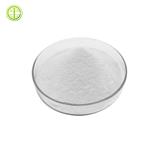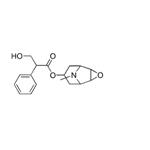Scopolamine is a type of alkaloid that exists in a variety of Solanaceae plants such
as Scopolia japonica, Datura metel L., and so on. It is the main active ingredient in
these plants.
Apart from scopolamine, several other chemical ingredients also exist in Scopolia
japonica, including hyoscyamine, anisodamine, anisodine, and so on. Hyoscyamine
is an inhibitor of parasympathetic nerve, with the analgesic and antispasmodic functions, especially for sciatica, sometimes for the treatment of epilepsy, seasickness,
etc., and its pharmacological effects are similar to atropine. However, its clinical
application is less because of its toxicity. The clinical applications of anisodamine
are treating infectious toxic shock, vascular disorders, various neuralgia, smooth
muscle spasms, vertigo, fundus disorders and sudden deafness, and other diseases.
It has definite curative effect and is widely used in clinical in China. Its synthetic
product is called “654-2,” which now still is an effective drug to treat infectious
shock and other vascular diseases. While anisodine is used to treat vascular headache, retinal vasospasm, ischemic optic neuritis, cerebrovascular disease, acute
paralysis, central dysfunction caused by carbon monoxide poisoning, tremor, paralysis, bronchial asthma, motion sickness, organophosphorus pesticide poisoning,
and so on .
White or almost white, crystalline powder or colourless crystals.
Appearance: a kind of viscous liquid, brown color. Solubility: soluble in ethanol,
ethyl ether, chloroform, acetone, and water, very soluble in hot water, slightly soluble in benzene and petroleum ether, and also soluble in cold water. It can generate
various crystals with multiple inorganic or organic acids. Melting point: 59±1.0?°C
Scopolamine is the main active ingredient of Scopolia japonica, Datura metel L.,
and other Solanaceae plants. As early as 1892, the chemist E.?Schmidt first isolated
it from the Scopolia japonica, so named it as scopolamine. Due to its obvious deficiencies in solubility and usage, the researchers modified its structure as scopolamine butylbromide, which was synthesized and used scopolamine and
bromo-n-butane with heating refluxing method. Preparation method of scopolamine
butylbromide is simple, and it’s easy to be synthesized. There are about 170 domestic enterprises producing its raw materials currently.
European Pharmacopoeia (9th ed.), United States Pharmacopeia (36), and the
Japanese Pharmacopoeia (16th ed.) contained bromine scopolamine; British
Pharmacopoeia (2015) contained the raw materials and preparations of scopolamine
butylbromide, including tablets and injections. Pharmacopoeia of the People’s
Republic of China (2015) contained its raw materials, injection, and capsules.
Scopolamine is used for practically the same indications as atropine, but it should be noted
that it has a sedative effect on motor activity, and it is recommended for the treatment of
Parkinsonian symptoms.
cholinergic (ophthalmic).
ChEBI: A tropane alkaloid that is the (S)-tropic acid ester of 6beta,7beta-epoxy-1alphaH,5alphaH-tropan-3alpha-ol.
Isopto Hyoscine (Alcon); Transderm-Scop (Ciba-Geigy);Diban;Donnagel-pg;Donnatal;Phenacon;Ru-tuss;Scopoderm tts;Spasmofen;Susano;Tropax.
World Health Organization (WHO)
Scopolamine, an alkaloid with anticholinergic activity extracted
from solanaceous plants, was introduced into medicine in 1888. It is used as a
mydriatic, as an anti-emetic for the control of motion sickness, and for
premedication in general anaesthesia. Shortly after their introduction in the early
1980's, transdermal delivery systems containing scopolamine that were indicated
for the prevention of motion sickness were associated with visual disorders (e.g.
mydriasis, glaucoma) and hallucinations. The action taken in Norway is in
accordance with the legislation in several other countries where these preparations
have always been subjected to prescription control.
Scopolamine (hyoscine) is found in variousmembers of the Solanaceae (e.g., H. niger, Duboisia myoporoides,Scopolia spp., and Datura metel). Scopolamineusually is isolated from the mother liquor remaining from theisolation of hyoscyamine.
Hyoscine is the older name for this alkaloid, althoughscopolamine is the accepted name in the United States.Scopolamine is the levo component of the racemic mixturethat is known as atroscine. The alkaloid is racemized readilyin the presence of dilute alkali.
The alkaloid occurs in the form of a levorotatory, viscousliquid that is only slightly soluble in water but very solublein alcohol, chloroform, or ether. It forms crystalline saltswith most acids, with the hydrobromide being the most stableand the most popularly accepted. An aqueous solution ofthe hydrobromide containing 10% mannitol is said to be lessprone to decomposition than unprotected solutions.
Scopolamine butylbromide, a modified scopolamine, is a peripheral anti-choline
drug; it not only can smooth muscle spasm but also block the ganglion and neuromuscular junction and has the weak effect on center. This drug has stronger effects
on intestinal smooth muscle spasm than atropine and anisodamine; it can selectively
relieve gastrointestinal tract, biliary tract, and urinary tract smooth muscle spasm
and inhibit its peristalsis. Scopolamine butylbromide has less effects on the heart,
pupil, and salivary gland, so it rarely induces central nervous excitement, dilation,
inhibition of saliva secretion, and other adverse reactions, which is unlike atropine.
Scopolamine butylbromide is an antagonist of the M cholinergic receptor, its
pharmacological effects are similar to atropine, but it has its own characteristics that
have an obvious advantage in improving blood microcirculation.
Oral absorption of scopolamine butylbromide is not easy. It produces efficacy at
2–4?min after intravenous injection, 8–10?min after subcutaneous or intramuscular
injection, and 20–30? min after oral administration, which could maintain about
2–6?h .
The commercially available transdermal system of scopolaminecomprises an outer layer of polymer film and a drug reservoircontaining scopolamine, polyisobutylene, and mineral oil, which is interfaced with a microporous membrane tocontrol diffusion of the drug. In this dosage form, scopolamineis effective in preventing motion sickness. The actionis believed to be on the cortex or the vestibular apparatus.Whereas atropine stimulates the CNS, causing restlessnessand talkativeness, scopolamine usually acts as a CNSdepressant.
Poison by intravenous, intraperitoneal, and subcutaneous routes. Moderately toxic by ingestion. Human systemic effects from very small amounts by subcutaneous and intramuscular routes: changes in surface EEG, dstorted perceptions, excitement, hallucinations, and mydriasis. It can cause the individual who is affected to lose a certain amount of his normal inhibitory control. It is for that reason that it has been called “truth serum.” An experimental teratogen. Experimental reproductive effects. Human mutation data reported. In many cases of poisoning from ths material, and even to a certain extent following its medcal application, there is retention of the urine caused by paralysis of the bladder, and catheterization is necessary. The fatal dose is variable. Death has occurred from as little as 0.6 mg, whde recovery has occurred from doses of 7-1 5 mg. An anticholinergc drug. When heated to decomposition it emits highly toxic fumes of NOx. See also ESTERS
Scopolamine, the L-9-methyl-3-oxa-9-azatricyclo[3.2.1.0.2,4]non-7-yl ester
of |á-hydroxymethylphenylacetic acid (14.1.6), can be synthesized from tropenol (14.1.2)
by oxidizing the double bond between carbon atoms C6 and C7 of the tropine ring, giving an epoxide derivative, scopine (14.1.5). Esterification of this product using tropic acid
gives scopolamine (14.1.6) [7,8].

AChR | 5-HT3 receptor | M1 muscarinic receptor | M2 muscarinic receptor
It is almost completely metabolized in the liver and is excreted via the kidneys. Its elimination
half-life is approximately 8 hours.
Crystallise it from *benzene/pet ether, EtOH or H2O. It is polymorphic with m 165-166o and 190-191o. The racemate has m 56-57o (H2O), 37-38o (2H2O), syrup (anhydrous), l and d isomers can separate as syrups when anhydrous. [Beilstein 27 H 99, 102, 27 I 247-248, 27 II 43-44, 27 III/IV 1790.]




